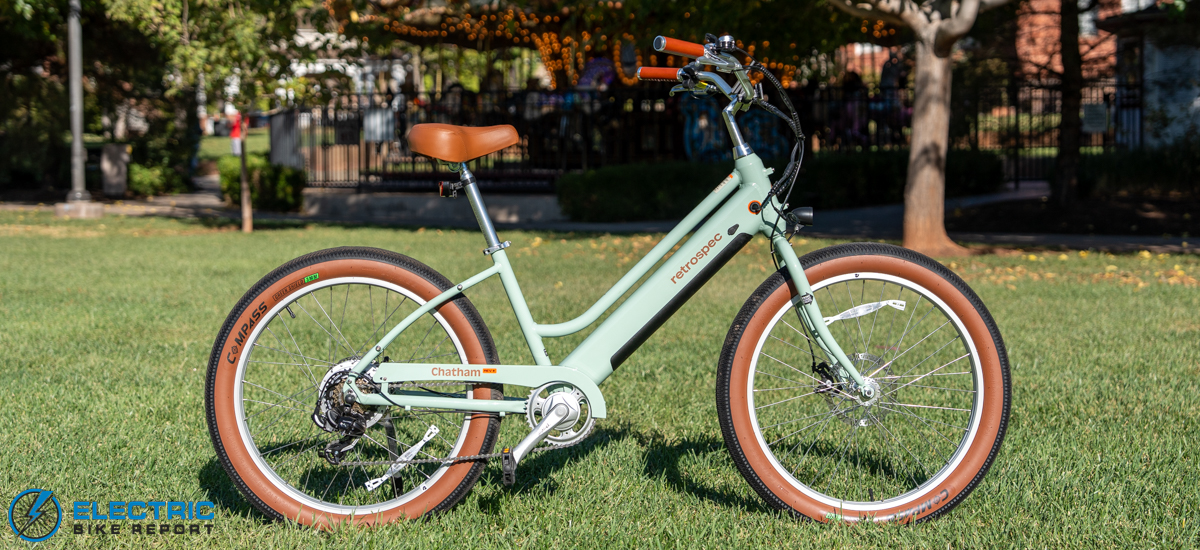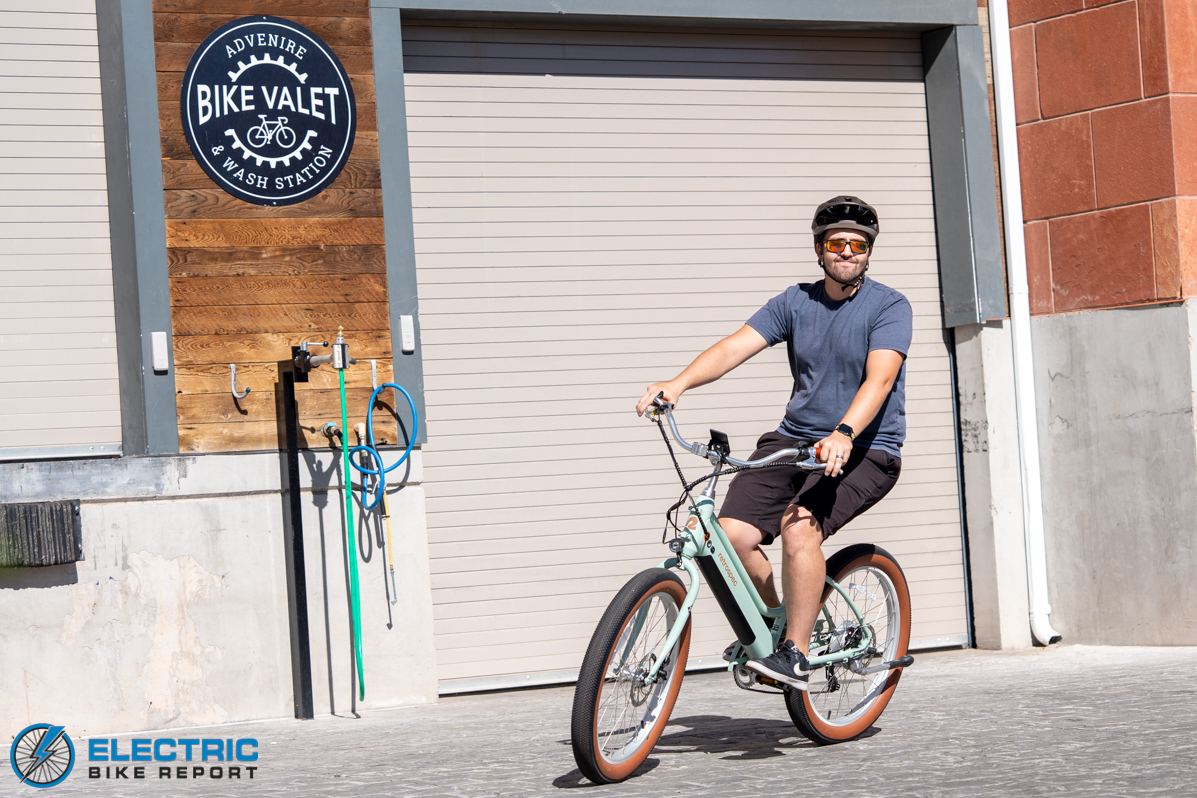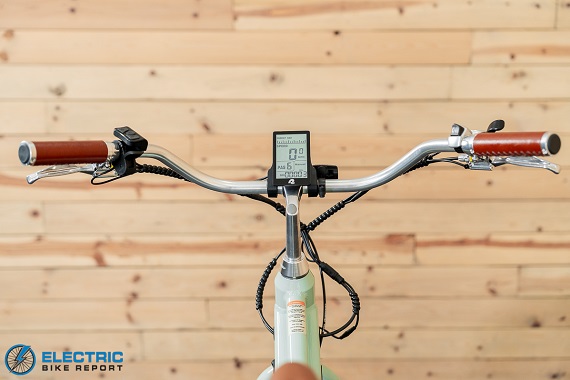Retrospec Chatham Rev+ ST Review
A comfortable, speedy, and affordable cruiser with classic yet contemporary design!

The bike’s appearance is really its defining feature, and we think Retrospec nailed the design by balancing form and function. The Chatham Rev+ uses a curved and angled top tube to keep the frame from flexing, while the larger, more contemporary down tube seamlessly hosts its fully integrated battery. It’s an artful design that perfectly fuses new and old!
We were pleasantly surprised by the bike’s pricing; the Chatham Rev+ has an uncommonly high-quality ride feel backed up by unexpectedly good performance for an e-bike starting around $1,300. The bike feels well-made, but also thoroughly thought out, with a number of small but impactful details included – like the chain guard and tires – to elevate its ride quality.
The 26”x3” Compass fat tires add comfort to the ride by absorbing vibrations from the road, but they’re not the only comfort element we appreciated. The bike’s upright riding position is relaxed and enjoyable, and its wide, thickly padded seat is accommodating. These elements, along with the curved handlebars, are defining features of cruiser-style bikes – and why their riders love them so much!
To get the full scoop on the bike’s specs, components, and real-world performance, see our full Retrospec Chatham Rev+ review below.
 Pros
Pros- Classic looks and style fused with a contemporary design – including a fully-integrated 48V, 500 Wh battery in the down tube.
- Affordability and value. The Chatham Rev+ ST had a better feel and performance than we expected for its base price of around $1,300.
- Comfort and accessibility. The low step-thru frame made getting on the bike easy, while its plush saddle, wide tires, and upright position made staying on even better.
- A powerful 48V, 500W rear-hub motor makes for an easy ride on hilly and flat terrain alike.
- The 500 Wh battery has plenty of juice to keep you riding longer between charges.
- It’s available in four unique color options – Matcha, Eggshell, Everglade, and Matte Navy.
 Cons
Cons- Six pedal assist settings felt like too many for a Class 2; we suggest Retrospec reduce the number to 4 for ease of use.
- It’s something we’d likely get used to, but we found the battery charge readout to be fairly unreliable.
- Battery : 48V/500Wh, LG 21700 cells, Charge on or off bike
- Display: B&W LCD center mount display
- Motor: 48V/500W geared rear-hub
- Headlight: Integrated/system operated front light
- Taillights: Battery operated rear light
- Pedal Assist: 6 levels of assist, cadence sensor
- Range: 52+ miles (claimed)
- Throttle:throttle on demand, thumb operated
- Claimed weight: 59 lbs (actual)
- Rider height range: 5’-2” to 6’-1”
- Total payload capacity: 350 lbs
- Brakes: Tektro mechanical with 180mm rotors and semi-metallic pads
- Fenders: Optional, not included
- Fork: Rigid Steel
- Frame: 16.5” Step Through, Alloy, 6061
- Drivetrain: 7-Speed Shimano Tourney, 42T chainring, 14-34T cassette
- Grips: Comfort with alloy lock rings
- Saddle: Comfort Cruiser
- Handlebar: Alloy cruiser
- Kickstand: Rear mount, adjustable, aluminum alloy
- Pedals: PP platform 9/16″
- Tires: 26×3.0 with puncture protection

You can’t deny that the Chatham Rev+ is a looker!

The 500W rear-hub motor can carry the bike up to 20 mph through throttle or pedal assist.

With a fully-integrated battery, the Chatham Rev+ has a more contemporary feel to its design.
Retrospec Chatham Rev+ ST Review: Speed Test
Our first point of discussion is the Speed Test, where we evaluate the bike’s motor power and the speed distribution of its six pedal assist system (PAS) settings. We rode the bike along a predetermined segment of the local bike paths and recorded our speed in each mode.
The Chatham Rev+ ST is a Class 2 e-bike with throttle and pedal-assisted speeds of up to 20 mph, and the bike utilizes a cadence sensor to engage its 48V, 500W rear-hub motor, so its speed is limited to specific thresholds in each PAS setting. We soft-pedaled the bike throughout this test to determine those thresholds, but riders can pedal above the specified limits.
With no assistance from the motor, we pedaled comfortably and easily at 9.6 mph. The bike’s lowest assist setting, PAS 1, provided a subtle boost in speed that carried us to 10.8 mph. This increased significantly in PAS 2, where we reached 14.7 mph. The speed increases when stepping up through PAS 3 and 4 were consistent; we measured 16.8 and 18.6 respectively. PAS 5 brought us near the 20 mph threshold at 19.3 mph, and in PAS 6, the motor carried us above the limit temporarily – to 20.8 mph – before settling at 20.2 mph for a steady “cruising speed.”

This bike is a capable commuter in addition to being well-suited to casual evening or weekend rides.

A 7-speed Shimano Tourney drivetrain keeps things simple but functional.

The tan-wall Compass tires look great and have great grip with low rolling resistance.
With that in mind, we were surprised to note that the bike offered 6 pedal assist settings; the industry standard is 5, but we usually prefer fewer on Class 2 e-bikes. With too many options, some settings go unused, and we think the Chatham would benefit with some streamlining. For ease of use, we suggest that Retrospec reduce the number of PAS settings to 4, and rebalance the bike’s speed/power distributions to be more even across all settings.
As it is, the bike’s current system offers a variety of options to allow riders to choose their preferred speed. Its power distribution is relatively intuitive, and overall it works well.
Retrospec Chatham Rev+ ST Review: Range Test
To evaluate the motor and battery efficiency of the Chatham Rev+ and determine practical values for its minimum and maximum range, we rode the bike in PAS 6 and again in PAS 1 until its battery expired. Our testing was, once again, performed on a network of local bike paths with varying changes in topography.
Using the bike’s maximum level of pedal assistance in PAS 6, we traveled a distance of 23.0 miles over the course of 1 hour and 29 minutes. When compared to similar cruiser-style e-bikes we tested previously, this is on the lower end, but the Chatham Rev+ also has a significantly smaller battery capacity – meaning that its results are on par.
In truth, the bike exceeded our expectations based on the specs of its 500W motor and 500 Wh battery. This combination meets the minimum ratio of motor watts and battery watt-hours that we prefer to see, which we estimated would grant the max-PAS portion of our test a duration of 1 hour and a distance of 20 miles. Our real-world test showed a nearly 50% increase in time and 15% increase in mileage – which we consider commendable considering the 471 feet of elevation change that we measured.
The Chatham Rev+ delivered an impressive result of 66.0 miles with its minimum level of pedal assistance in PAS 1. This significantly exceeded Retrospec’s advertised range of 52+ miles, and put the bike on par with many similar e-bikes that carry higher-capacity batteries. The Chatham Rev+ moved at a slower speed in its low-power test than many of those other e-bikes, but we consider this a fair trade.
Ultimately, the bike performed well; it offers a practical level of range for use as a daily commuter in addition to being an excellent option for leisurely rides. Those using the bike for longer daily rides may need to charge regularly when riding at top speed, but the battery should last for a number of shorter, more casual trips.
Retrospec Chatham Rev+ ST Review: Hill Test
On throttle, the bike climbed our test hill confidently in 1 minute and 25 seconds and maintained an average speed of 12.8 mph. In PAS 6, this time was reduced to 1 minute and 19 seconds and an average of 13.7 miles per hour.
Both of these results are significantly better than we’ve seen from similar cruiser-style e-bikes we’ve tested. In our experience, cruiser-style e-bikes tend to feel relatively low powered even when equipped with similar 500W motors; this gives them a more relaxed and casual feel that is well-suited to leisurely rides. The Chatham Rev+, on the other hand, felt punchier and therefore more capable on inclines; I noticed when testing the bike that even PAS 1 provided an appreciable level of assistance.
The Chatham Rev+ ST’s motor has a peak output of 600W and 55Nm of torque; both of these figures are relatively low in the grand scheme, so we reached out to the team at Retrospec to inquire about the bike’s more powerful feel. While they didn’t go into proprietary details about the bike or its programming, they shared that much time and care was put into selecting synergistic components – starting with the controller.
The result of this synergy is clearly a motor that delivers plenty of uphill power. With the combination of its cadence sensor and rear-hub motor, the process of climbing hills is made simple, comfortable, and easy whether pedaling or using the throttle.

Cruising comfortably is a core part of the Chatham Rev+’s ride!

We liked the aluminum trim on many parts of the bike including the brake levers.

The Tektro disc brake system uses 180mm rotors on both wheels.
Retrospec Chatham Rev+ ST Review: Brake Test

The Retrospec Chatham Rev+ ST uses a mechanical disc brake system made by Tektro. We evaluated the bike’s brake performance using the process described above, and calculated an average stopping distance of 21’-2”.
This result is significantly better than expected based on the fact that the bike uses a mechanical system. Hydraulic brake systems are usually known for better responsiveness and overall stopping power, but the Chatham Rev+’s results were over 2 feet better than the average for all the cruiser-style e-bikes we’ve tested.
We attribute the Chatham Rev+ ST’s excellent performance to two of its components: first, the quality and performance of Tektro brakes; and second, the width of its 26”x3” Compass tires. Tektro is a reputable brand with solidly-performing brakes – enough said. But we have not often tested cruiser-style e-bikes with such wide tires; most are in the 2-2.5” range. The added rolling resistance of the Chatham’s wider tires, as well as their heavily textured tire tread, likely helped to slow the bike faster than average.

The bike’s wide, swept-back handlebars are comfortable and have plenty of real estate for other accessories.

With a chain guard, messy pant legs are a thing of the past.

Big, comfy saddles are defining features of cruiser-style e-bikes like the Chatham Rev+.

The integrated LED headlight might be small, but it’s bright for its size!
Retrospec Chatham Rev+ ST Review: Ride Quality
The primary location of adjustment on the bike is its seatpost; it offers roughly 6.5” of adjustment in height. The forward/backward position of the saddle can also be adjusted slightly to change the rider’s reach; the saddle’s rails are roughly 2.25” long. With a stationary standard-style stem, the bike is limited in handlebar adjustment, but the curved handlebars can be rotated to adjust hand placement.
Comfort is again one of the primary elements of the Chatham Rev+. In addition to the bike’s relaxed riding position, cushy saddle, and natural-feeling hand placement on its grips, we appreciated the added comfort when riding over bumps from the 3” tires. This is especially important considering the bike’s rigid frame; with no suspension, the bike would otherwise have a much rougher ride.
The bike’s user interface is straightforward; we liked that the control panel was small and uncomplicated, and also that it nests overtop of the throttle lever to improve looks and save on space.
With the price point of the Chatham Rev+, we did not expect anything more than a simple black-and-white display, but during our testing we found that the battery display was relatively unreliable. With more time on the bike, we likely would have adjusted to the fact that the battery did not last for more than a few miles once the indicator was reduced to one segment (the indicator looks more like the marks on a ruler than a typical bar-based readout), but users should be aware that the charge level was never completely reduced to zero. We hope that Retrospec improves the accuracy and reliability of this display in the future and perhaps switches to a percentage-based readout.
Being nitpicky, we wouldn’t mind seeing an integrated taillight as well as improved cable management, but we appreciated that the bike included some useful essentials. We don’t often consider the included Shimano Tourney over-the-bar shifter to be a favorite, but in this case, it felt well-suited to the bike and the wrist positioning of its handlebars.
The Chatham Rev+ includes minimal accessories, such as a small integrated headlight, a battery operated tail light on the seatpost, and a chain guard. It has mounting points for a cargo rack, a basket, and fenders; at the time of writing, these optional accessories are not yet offered on Retrospec’s website, but our contact advised us that they will be coming soon.
In terms of handling and ride feel, we found the Chatham to be predictable, meaning that it felt intuitive and responded appropriately based on its design. We found the motor to be effective and quick to engage, though with the 7-speed drivetrain, we did experience some ghost pedaling. On a performance-oriented bike we would consider this a problem, but in the case of the Rev+, we think it fits the casual cruiser experience.
Overall, the ride quality of the Chatham Rev+ was solid and enjoyable, and we think it has mass appeal for riders seeking a comfortable and unique-looking e-bike.

On the left handlebar, the bike’s throttle lever is tucked behind the small control panel.

The over-the-bar Tourney shifter fits the feel and style of the Chatham Rev+.

The black-and-white LCD is easy to read, though we wish the battery charge indicator was more accurate.

While there is no included suspension, the 26”x3” Compass tires help to absorb vibrations.
Retrospec Chatham Rev+ ST Review: Summary / Where to Buy
Cruiser-style e-bikes tend to encourage a relaxed and casual approach to exercise and enjoyment. The Chatham Rev+ certainly offers this option to its riders, as it can ride slower for a more leisurely experience – but can also provide the added thrills we typically associate with more aggressive e-bikes; its punchy motor can dish out power for fast acceleration and speed if desired.
We have a few points of critique, but ultimately the Chatham Rev+ ST’s flaws are minor. We think the bike would benefit from a reduction in the number of its PAS settings, and we’d prefer a more accurate battery readout on the display, but otherwise, we have no complaints. No e-bike is perfect, and such small flaws can be easily overlooked when considering how many things Retrospec did right!
We were highly impressed by the bike’s performance in our Hill, Brake, and Range Tests, though it performed well across the board. It delivered a great feel, the performance of an e-bike with a significantly higher price, and an awesome retro design with a modern flair!
Happy Riding! Make sure to let us know if you have any questions or if you think we left anything out in this review of the Retrospec Chatham Rev+ ST down in our comments section.




I tried to fill out your survey but it led to YouTube, where I was expected to sign in. I gave up on that a while ago because of the censorship.